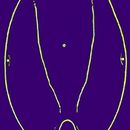fi
nimet breadcrumb-navigoinnissa


Testudinella bicorniculata is characterized by two antero-lateral lorica projections; dorsal and ventral anterior margins undulate with shallow median sinus; foot opening sub-terminal, inverted Ushaped slit; distal foot pseudosegment short; manubria with well developed sub-ventral chamber; fulcrum with proximal opening.
Type locality. Mediterranean, Parc national Port-Cros, Île de Bagaud, Pointe de Montrèmian, France: depth 25 m, distance from shore ~8 km, 27 July 2006.
Holotype. A female in a permanent, glycerine glass slide mount deposited in the Royal Belgian Institute of Natural Sciences (RBINS), Brussels, Belgium, No. IG. 30986, RIR 190.
Paratypes. 8 females from type locality. One female in RBINS (RIR 191); one female in ANSP 1973; one mounted paratype and 5 SEM trophi preparations in department of Biology, University of Antwerp.
Additional material. 16 females collected in psammon from Mediterranean: Spain, Bègur, Bay of Aiguafreda, Furio de Aiguaxelida (3), depth 28 m, distance from shore ~250 m, water temperature 24 °C, 17 August 2006; Italy, Elba Island: Punta Madonna (1), La Fonza Esterna (4), La Formiche di Ponente (5), Scoglietto di Portoferraio (2), Scoglio della Nave Enfola (1), depth 30–40 m, distance from shore ~50–1000 m, 25–30 September 2006.
Etymology. The name of the species is composed of the Latin bis, meaning twice, and the Latin adjective corniculata, meaning provided with a small horn, and refers to the small antero-lateral projections of the lorica.
The species was to date only sampled in small numbers from psammon collected in the Mediterranean, at depths of 25–40 m and distances from the shore varying from 50 m to 8 km, during July–September. Water temperatures varied from 21–24 °C. It occasionally co-occured with the related T. obscura and T. elongate.
Marin psammon
The new species superficially resembles T. robertsonae Koste, 1990 (in Koste & Robertson, 1990) and T. truncata (Gosse, 1886) which also bear antero-lateral projections. T. robertsonae is more squat (ratio lorica length/width 1.1–1.2 versus 1.4–1.6 in the new species), and shows a transversal elliptical foot opening (inverted-U shaped split in T. bicorniculata). Testudinella truncata is more slender anteriorly, resulting in a more elongate vase-shaped lorica; its foot opening is terminal and more or less rectangular instead of subterminal and U-shaped. A median fold as present at the antero-ventral lorica margin in T. robertsonae and T. truncata is absent in T. Bicorniculata. The trophi of T. truncata (De Smet, 2005; no SEM data available for T. robertsonae) display a higher number of teeth (12/12) and arched rami scleropili (~22/25), and the heads of its major teeth are more slender and only weakly offset. The most characteristic differences in trophi structure concern the subventral manubrium chambers and proximal fulcrum opening present in the new taxon, but absent in T. truncata. Both T. robertsonae and T. Truncate (except for a single specimen record from slightly saline (328 mg Clֿ .Lֿ ¹) inland water by Althaus (1957a), are inhabitants of freshwater. The morphology of the trophi and shape of the foot opening suggest a relationship with T. clypeata, T. obscura and T. elongata.
Description of female. The smooth lorica is vase-shaped, truncate anteriorly with acute anterolateral projections; ratio length/width 1.39–1.55 (average 1.50). The dorsal and ventral anterior margins are undulate with shallow median sinus; the dorsal anterior margin is slightly projecting beyond the ventral margin. The posterior margin is smoothly rounded or very weakly rounded-angular. Ventrally two longitudinal furrows delimit a protruding median part. In cross-section the lorica is slightly arched dorsally with shallow elevation near the lateral margins; ventrally almost flat with median part weakly protruding. The foot opening is an inverted U-shaped slit widening distally, situated near posterior 1/5 on the ventral side. The foot is composed of a long wrinkled proximal part, a short penultimate pseudosegment, and a slightly longer distal pseudosegment ending in a ciliated cup. The ratio lorica length/position of antennae relative to dorsal anterior margin varies between 2.50–3.04 (average 2.72) for the dorsal antenna and 2.03–2.36 (average 2.18) for the lateral antennae. Two red eyespots.
Trophi: Trophi malleoramate. The rami are elongate-triangular with rounded latero-ventral margins, and short caudally recurved blunt alulae. Basal and subbasal chambers not separated by partition, forming a large chamber opening latero-ventrally by a large common fenestra. Asymmetrical and interlocking median rami apophyses are apparent in caudal view. The inner margins of the distal rami sections bear 11–14/11–16 (left/right) arched and fairly strongly webbed rami scleropili. The basal apophyses are moderately developed ridges, composed of a series of fused scleropili. The fulcrum is short and plank-shaped, more or less trapezoid in lateral view. It is composed of a double layer of longitudinally oriented and appressed sclerite bodies, the caudal series of which is involved in the formation of the junction with the rami, and an anterior series which border a distinct opening proximally. The unci plates consist of 10–11/10–11 (right/left) straight teeth, running parallel and strongly webbed, with interlocking heads; space between teeth fairly large. Each uncus has three major teeth, the midst distinctly the smallest, with strongly clubbed head. The head of the minor teeth is weakly offset, relatively long and more or less cylindrical. The crescent shaped manubria are composed of the superimposed dorsal, median and ventral chamber, and moreover show a well developed sub-ventral chamber.
Male unknown.
Measurements. Lorica length 124–143 μm (mean=135 μm, N=12), lorica width 87–93 μm (mean=90 μm, N=12), antero-lateral spine 4–6 μm (mean=5, μm, N=20), penultimate foot pseudosegment 7–8 μm (mean=8 μm, N=5), distal foot pseudosegment 14–16 μm (mean=15, N=5); trophi: length × width 16.0–16.5 × 22.0–23.0 μm, ramus 12.0–12.5 μm, fulcrum 4.5–5.5 μm, largest major tooth 11.5–12.0 μm, manubrium 12.0–12.5 μm.